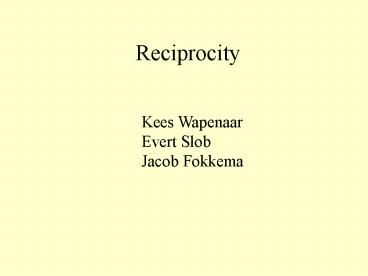Reciprocity - PowerPoint PPT Presentation
1 / 46
Title:
Reciprocity
Description:
Reciprocity Kees Wapenaar Evert Slob Jacob Fokkema Review of reciprocity theorems Convolution type Correlation type Unified notation Acoustic Elastodynamic ... – PowerPoint PPT presentation
Number of Views:1198
Avg rating:3.0/5.0
Title: Reciprocity
1
Reciprocity
Kees Wapenaar Evert Slob Jacob Fokkema
2
- Review of reciprocity theorems
- Convolution type
- Correlation type
- Unified notation
- Acoustic
- Elastodynamic
- Electromagnetic
- Poroelastic
- Seismoelectric
- Review of boundary conditions
- Extension of reciprocity theorems
- Conclusions
3
- Review of reciprocity theorems
- Convolution type
- Correlation type
- Unified notation
- Acoustic
- Elastodynamic
- Electromagnetic
- Poroelastic
- Seismoelectric
- Review of boundary conditions
- Extension of reciprocity theorems
- Conclusions
4
A
B
State A
State B
5
A
B
State A
State B
6
kA, rA
kB, rB
PB
QB
QA
PA
State B
State A
7
PB
QB
QA
PA
State B
State A
8
PB
QB
QA
PA
State B
State A
Convolution-type reciprocity theorem forward
problems
9
- Review of reciprocity theorems
- Convolution type
- Correlation type
- Unified notation
- Acoustic
- Elastodynamic
- Electromagnetic
- Poroelastic
- Seismoelectric
- Review of boundary conditions
- Extension of reciprocity theorems
- Conclusions
10
PB
QB
QA
PA
State B
State A
Correlation-type reciprocity theorem
11
Q
Q
P
P
State B
State A
Power dissipated in medium
Power-flux through boundary
Power radiated by sources
12
PB
QB
QA
PA
State B
State A
Correlation-type reciprocity theorem inverse
problems
13
- Review of reciprocity theorems
- Convolution type
- Correlation type
- Unified notation
- Acoustic
- Elastodynamic
- Electromagnetic
- Poroelastic
- Seismoelectric
- Review of boundary conditions
- Extension of reciprocity theorems
- Conclusions
14
PB
QB
QA
PA
State B
State A
Convolution-type reciprocity theorem
15
Unified notation (convolution type)
16
Unified notation (convolution type)
17
Unified notation (convolution type)
18
- Review of reciprocity theorems
- Convolution type
- Correlation type
- Unified notation
- Acoustic
- Elastodynamic
- Electromagnetic
- Poroelastic
- Seismoelectric
- Review of boundary conditions
- Extension of reciprocity theorems
- Conclusions
19
(No Transcript)
20
PB
QB
QA
PA
State B
State A
Correlation-type reciprocity theorem
21
PB
QB
QA
PA
State B
State A
22
Unified notation (correlation type)
23
- Review of reciprocity theorems
- Convolution type
- Correlation type
- Unified notation
- Acoustic
- Elastodynamic
- Electromagnetic
- Poroelastic
- Seismoelectric
- Review of boundary conditions
- Extension of reciprocity theorems
- Conclusions
24
n
n
V
V
PB
QB
QA
PA
State B
State A
Perfectly coupled interfaces
No consequences for reciprocitytheorems of
convolution type and correlation type
Next consider partially coupled interfaces
25
Review of linear slip model
Displacement jump
26
Review of linear slip model of Schoenberg
27
Review of linear slip model of Pyrak-Nolte et al.
28
Review of linear slip model of Pyrak-Nolte et al.
Frequency domain
29
Review of linear slip model of Pyrak-Nolte et al.
30
Review of linear slip model
31
Horizontal interface
32
Generalized boundary condition
33
(No Transcript)
34
- Review of reciprocity theorems
- Convolution type
- Correlation type
- Unified notation
- Acoustic
- Elastodynamic
- Electromagnetic
- Poroelastic
- Seismoelectric
- Review of boundary conditions
- Extension of reciprocity theorems
- Conclusions
35
n
n
V
V
PB
QB
QA
PA
State B
State A
36
n
n
V
V
PB
QB
QA
PA
State B
State A
37
n
n
V
V
PB
QB
QA
PA
State B
State A
Convolution-type reciprocity theorem forward
problems
38
n
n
V
V
PB
QB
QA
PA
State B
State A
Correlation-type reciprocity theorem
39
n
n
V
V
State B
State A
Power-flux through boundary
Power dissipated in medium
Power radiated by sources
Power dissipated by interfaces
40
n
n
V
V
PB
QB
QA
PA
State B
State A
Correlation-type reciprocity theorem inverse
problems
41
- Review of reciprocity theorems
- Convolution type
- Correlation type
- Unified notation
- Acoustic
- Elastodynamic
- Electromagnetic
- Poroelastic
- Seismoelectric
- Review of boundary conditions
- Extension of reciprocity theorems
- Conclusions
42
Unified reciprocity theorems have been
formulated of the convolution and correlation
type
43
Unified reciprocity theorems have been
formulated of the convolution and correlation
type Valid for acoustic, elastodynamic,
electromagnetic, poroelastic and seismoelectric
waves
44
Unified reciprocity theorems have been
formulated of the convolution and correlation
type Valid for acoustic, elastodynamic,
electromagnetic, poroelastic and seismoelectric
waves Boundary condition for imperfectly coupled
interface
45
Unified reciprocity theorems have been
formulated of the convolution and correlation
type Valid for acoustic, elastodynamic,
electromagnetic, poroelastic and seismoelectric
waves Boundary condition for imperfectly coupled
interface No effects on source-receiver
reciprocity
46
Unified reciprocity theorems have been
formulated of the convolution and correlation
type Valid for acoustic, elastodynamic,
electromagnetic, poroelastic and seismoelectric
waves Boundary condition for imperfectly coupled
interface No effects on source-receiver
reciprocity Imaginary part of accounts
for dissipation by interfaces































